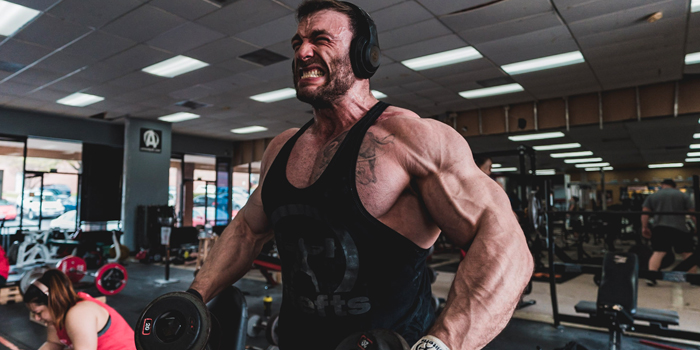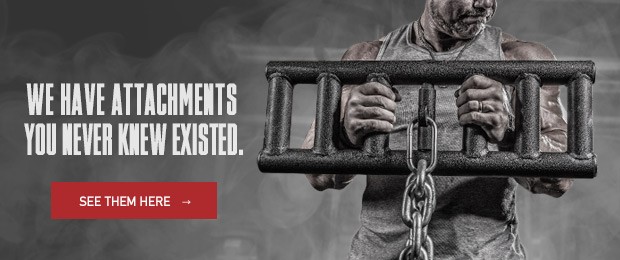
The Bodybuilding for Powerlifting series describes how you can incorporate bodybuilding methods into your powerlifting training for big benefits in strength and aesthetics. This sixth installment discusses programming, a topic we haven’t covered so far in the series. You can check out the earlier articles here:
- The Vacuum and Reverse Hyperextension
- Rear Delts Rows
- Widen Your Grip to Beef Up Your Back and Deadlift
- Adductor Work for Added Gains
- Get a Grip on Your Guns
- How to Use High Reps to Get Strong(er)
- Programming Arm Training (With Sample Routine)
Earlier this year, I began to dabble in bodybuilding. In this coaching blog post, I explained that a lot of my bodybuilding aspirations came from studying the “Golden Era” while I earned my Ph.D.
If you look at the history of physical culture, most of the true legends of the iron game – men like Eugen Sandow, John Grimek, and Bill Kazmaier – they were all about more than just strength. They had incredible strength, but they also had incredible physiques. In fact, many professional strongmen (like Sandow) include posing alongside feats of strength in their shows. Indeed, even the earliest physique contests often required some demonstration of strength-related athletic performance, like performing Olympic or odd-object lifting.
It makes sense – after all, bodybuilding and powerlifting are complementary. A bigger muscle is a stronger muscle, and if you get stronger, you’ll get bigger. That’s why so many powerlifters want to GFH, and why so many top bodybuilders are strong as hell.
Now, in the past twenty years or so, as strength sports have matured, the degree of specialization has really skyrocketed. There’s a lot of academic theory I could talk about here, but basically, it comes down to the fact that as a sport becomes more popular, methods of training for that sport become more specific. The greater number of participants usually means that you have to rely on those specific training methods if you want to compete at the highest levels. But training for balance has benefits, too, and very recently, it’s become more popular in both bodybuilding and powerlifting. In bodybuilding, the idea of balance came in with the classic physique division, which emphasizes aesthetics over pure size. Sure, the top bodybuilders must display perfect symmetry in addition to overwhelming size, but given the weight class limits in classic physique, symmetry becomes far more important.
In powerlifting, balance is only incidentally related to aesthetics. Everyone still wants to be as strong as possible – you’re not getting any pounds added to your total for having huge biceps. But instead of just trying to get strong by getting as big as humanly possible, many lifters are paying more attention to their muscularity. By staying lean, they can compete in lower weight classes without sacrificing any strength, which can be a huge advantage in overall placings. Just take a look at Larry Wheels or Dan Green, and you’ll immediately know how successful this strategy can be.
Of course, it ain’t easy. Now might be a good time to watch these highlights from one of my recent powerbuilding sessions to get an idea of the hard work that’s required to make this style of training successful.
My Powerbuilding Philosophy
I am a powerlifter. More than anything else, I want to be as strong as I can possibly be, and because of that, I’m obviously a bit biased in how I approach my training. But, I’m not so biased that I totally ignore the benefits of bodybuilding. Again, bodybuilding and powerlifting are complementary – there’s no way around that!
In fact, in most cases, I’d argue that a “powerbuilding” approach is ideal, rather than a specialization routine. Powerbuilding is a bit of a vague term, but in my mind, it just means that you’re focused on gaining strength, but use both strength-specific training methods and methods that are intended specifically for muscular growth. Powerbuilders also pay attention to their diet, work to improve their mind-muscle connection, and train all of their muscle groups – not just the ones most important in the squat, bench, and deadlift.
Of course, at some point, specialization is still king. That point is far, far, far away for most people. Shoot, just take my experience at this year’s US Open. I “prepped” for the meet with heavy weights for just a month, and the rest of my training was comprised entirely of bodybuilding work. I ended up winning my weight class, but finished just fourth overall.
I have no idea if I would have placed better had I spent a solid 12-16 weeks prepping instead, but I have no doubt that I would have put up a bigger total. And that’s my point: specialization might make a small difference in your results… when you’re prepping for the biggest meet in the world. Until you’re at that level, the benefits of training for balance by doing both powerlifting and bodybuilding outweigh the drawbacks. And even then, you’ll still benefit from a general approach in at least some parts of your training cycles.
Sample Back and Bicep Powerbuilding Routine
Now, you can’t just throw a bunch of high-rep sets into your current program and expect to get any benefit out of it. A training program has to be cohesive, and hypertrophy work specifically must be very goal-oriented to be worthwhile. Mindlessly banging out reps isn’t going to cut it.
Here’s a sample training session to give you an idea of what I’m talking about. It’s not just a laundry list of exercises – the “trick” is in how you perform the movements, which is why the explanations here are so extensive and so important. (And if you haven’t already, make sure to scroll up and check out the YouTube video there so you can have a visual of these movements!)
- Facing-Away Lat Pulldown: 4 sets of 20/15/12/10 reps
I really like the facing-away version of the standard pulldown, because it allows for a straighter bar path. This is much like a behind-the-neck pulldown, but without any added stress placed on the shoulder joint. That straighter bar path means that you can more easily pull through a full range of motion. Even better, because you don’t have a knee pad to brace against, you won’t be able to cheat out any reps by using your lower back. This makes it a perfect warm-up movement, but, at the same time, you won’t be able to load it up as heavily as you might like.
- (Superset) Hammer Strength Lat Pulldown with Bands/Wide-Grip Seated Row: 3 sets of 10 reps each
Mark Dugdale calls this Hammer machine the best one in the gym: “It's nearly impossible to duplicate with free weights what this machine can do. Several training methods work great on this machine, like maximum tension alternating pulls (hold one side isometrically in the contracted position at the bottom while the other side is moving). It also works great with bands for added accommodating resistance.”
While you can rely solely on band tension here, I prefer to add a plate and use a little less tension, as I find it produces a smoother strength curve.
Similarly, on the wide-grip seated row, you can activate the entire back musculature by pulling the bar to a point high on your torso – near the upper abs – emphasizing the upper lats, rear delts, and rhomboids. Then you can drop it down on the negative, getting a great stretch in the lower lats and erectors.
- Progressive Pulls: Sets of 6 to a top set
This is an old-school technique that I first learned about when reading John McCallum’s Keys to Progress series in old issues of Bob Hoffman’s Strength & Health magazine. (Speaking of iron game legends, McCallum is one of the best writers in strength and physique history. I strongly recommend you check out his work if you aren’t familiar with it.)
Here’s how it works:
- Start out doing strict bent-over barbell rows with a very light weight. Only do six reps, even if you could do many more.
- Add weight, and do another set of six.
- Keep repeating step two until you can’t maintain strict form on your barbell rows. At that point, continue to add weight and crank out sets of six, but use a little bit of body English to help you move the weight.
- When your rows start to get straight-up sloppy, keep adding weight and performing sets of six, but switch to wide-grip deadlifts instead of rows. You’ll probably want to use straps.
- When you can’t complete a full set of six on deadlift, hold your last set at the top, and perform a max-rep set of shrugs.
You’re shooting for 8-10 total sets here, so make sure you’re not resting more than two minutes between sets (or you could probably go forever).
- (Superset) Alternating Incline Dumbbell Curls/Dumbbell Upright Row: 2 sets of 15-20 reps
I like to train my rear delts together with my upper back, because they’re used so much in pulling movements already. Training those muscles together means that they both get a little more rest.
On your dumbbell curls, start out with your wrist in a neutral position, and supinate as you curl up. Maintain that supination on the eccentric portion of the movement. It’s a very nuanced change from the typical dumbbell curl, but it will allow you to emphasize the biceps muscle without putting too much strain on the elbow joint.
- (Superset) Reverse Curls/Band Pull-Aparts: 2 sets of 15-20 reps
By this point in the training session, if you’ve been working with the necessary intensity and at a good pace, you’re probably going to be feeling pretty darn fried. That’s okay – in fact, it’s a good sign to wrap up the training session. I allow myself one movement (or in this case, super-set) where I just do whatever it takes to crank out the reps. Then it’s time to go home and recover.
The Big Picture
For me, the big takeaway here is all about the details. When you’re training for both size and strength, to avoid making compromises in your results, you’ve got to maximize the efficiency of your training. If you want to make your hypertrophy work more efficient, all you can do is perform each and every rep with perfect technique, doing the best you can to emphasize the target muscles, and not all of the secondary ones that are inevitably involved in barbell work.
If this type of training appeals to you, check out one of my powerbuilding programs, like Think Big, or the one described in the YouTube video above! And even if it doesn’t, I strongly suggest that you still sift through training methods from other strength disciplines occasionally. Go ahead and pick and choose the techniques or movements that seem promising, and ignore the rest. It’ll still require a lot of trial and error to figure out whether your strength routine really does need a few more curls, or if your bodybuilding would benefit from heavy squats. But, if you can remain open-minded and put in the effort to find what works for you, I promise you’ll benefit.










